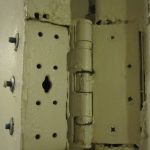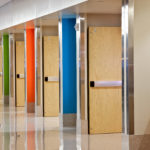 Last week I posted some Wordless Wednesday photos of a propped open fire door, and one of my coworkers asked: What steps would need to be taken to solve the problem? This is a great question!
Last week I posted some Wordless Wednesday photos of a propped open fire door, and one of my coworkers asked: What steps would need to be taken to solve the problem? This is a great question!
On the door in the photo, a kick-down stop (hold-open) has been installed on a stairwell door. If you’re not familiar with why this is an issue, the original post has that info.
To resolve the problem created by the installation of the kick-down stop, the first (and obvious) step would be to remove the stop. This would leave several fastener holes in the fire door, but based on the NFPA 80 standard, these holes could be filled by installing steel fasteners in the holes. If the kick-down stop was originally installed with steel screws, those fasteners could be used to fill the holes.
After the holder is removed, the door should be checked to make sure that it closes and latches properly. But WAIT! I would take it one step further. Clearly, someone wanted this door to be held open, and that’s why the stop was installed. Because this is a fire door, the hold-open must release upon fire alarm or smoke detection. There are various listed products that could be used, including wall- or floor-mounted magnetic holders, and automatic-closing closer/holder units.
In some locations, the door may only need to be held open momentarily – for a minute or two as large groups of people pass through or while someone carries something through the opening. In this case a delayed action closer could be installed. A change was made to the 2018 edition of the International Building Code, to clarify that delayed action closers are acceptable on fire door assemblies.
Once the modifications are complete, there is one more step – a fire door assembly inspection. Beginning with the 2013 edition, the NFPA 80 standard has required fire doors to be inspected after installation and after maintenance work, in addition to the annual inspection that has been required since the 2007 edition.
Are there any other steps that you would take to ensure that this assembly is code-compliant?
Thanks to Marc Zolner of Allegion for this Wordless Wednesday photo!
You need to login or register to bookmark/favorite this content.










Isn’t the bigger question, “How do you stop manual hold open devices (including door wedges) from being applied to fire doors and keep them off?”
All you can do is educate the Facility Managers and users about the code and the dangers of not allowing a fire door to self close and latch. It’s a never ending battle. They hear you but don’t listen.
What I find helpful is to show them photos (Lori has posted many) of a facility after a fire. The office side has a closed door with some smoke damage on the wall directly above the opening. The other side is a completely devastated factory.
Lori,
In Alberta the Fire Safety Codes Inspectors, are allowing Wedge Holders and Spring Holders. that do not require someone to Stop and bend over to release or remove.
The Caveat is, for each door with one of these types of holders, there must be a minimum of 2 persons responsible for making sure they are released or removed upon the Activation of the Buildings Fire Alarms.
I have gone into residential buildings, doing Inspections and Audits for Emergency Egress and Fire Doors, where there is the approved devices installed, and asked to see the list of the persons for each floor responsible, as this list must be maintained in the Buildings Fire Plans.
Most do not have a list or if they have persons designated for this task, they do not have them on a list.
Then we advise them that they are not up to code and we cannot provide Verification Report for the Audit/Inspection.
Then we advise the areas Safety Code Inspector, with a copy of the deficiencies in the building, giving the Building a copy of the report to the inspector(s).
I know the Inspectors will be returning to the building within 5 business days to issue their report and possible fines for the deficiencies.
I find that really crazy – is it just me?! Is that written down somewhere?
– Lori
Not just you…
Most often, in my opinion, people prop doors open because opening them by hand is too much of an imposition. In that case, a magnetic hold-open tied to the building fire alarm is the only way to go.
Lori,
Let me look into this, as I work very closely with the Safety Codes Officers, as I helped them develop a training course for their new Inspectors, so they were aware of the different types of door hardware, and the necessary labels to look for on all types of Fire Doors.
As has been noted, educating the educators is important. Having had a new vocation/technical school and two other public schools having major renovations, I can say that I’d push for some sort of brief class at the beginning of the school year. Teachers don’t seem to know their responsibilities in the Life Safety Code, and being able to give a short class on FD expectations and life safety system components would seem to be a great place to start. Going to push for this locally and see where we get.